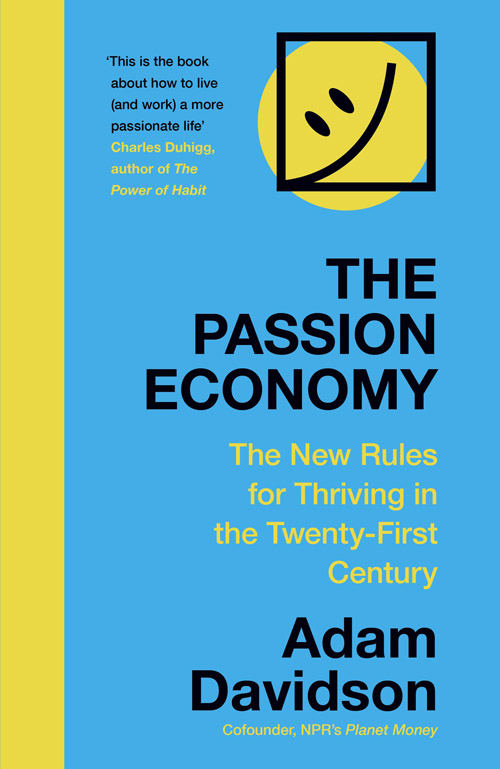Even if you haven’t studied economics, the old tenets of ‘business success’ are still widespread. Ruthless cost-cutting and strict adherence to efficiency in the face of competition are part of what makes up our general idea of making it rich. In The Passion Economy: The New Rules for Thriving in the Twenty-First Century (Hachette), award-winning economics journalist Adam Davidson plots a different course.
He argues that the foundation of our business understanding has its roots in the hyper-industrialised 20th century. In The Passion Economy, Davidson argues that there’s a path to prosperity and satisfaction through radically rethinking this paradigm. 
The Passion Economy plots a new course for success in business in the 21st century. Adam Davidson lays down a blueprint for satisfaction and prosperity.
It seems important to preface this review by explaining what the book isn’t trying to do. A prescriptive, ‘get rich quick’ guide it is not (though there are some rules). Instead, it offers examples of new and established businesses who are all grappling with the diverse economic challenges that they face in a new era.
Of course, to find out what’s new, we need to discover what’s old; Davidson does a great job of couching the challenges of modern business in a deep, historically rich context. Davidson’s own family history couldn’t have better exemplified the schism between old and new schools of thought when approaching one’s career and ultimately, manhood.
His father, Stanley, has been an actor for decades. Not a Hollywood celebrity, but with enough work to comfortably sustain his small family. His grandfather, also Stanley, worked in ball-bearings factory for half a century. It doesn’t take much to figure out which of the Stanleys made more money, and who was happier. Davidson writes, “When I began my adult life in the 1990s, I believed the stories the two Stanleys told. I believed that I had a choice to make: money or passion, financial comfort or fulfillment.”
This dichotomy looms large as most of us transition into adulthood. It’s this commonly-accepted myth that Davidson convincingly debunks in the book.
Early on, Davidson lays down the rules for The Passion Economy. Some seem obvious, but it’s only when you compare them to historical realities that they begin to feel counterintuitive. For example, Rule #2: Only Create Value That Can’t Be Easily Copied. Seems like a business no-brainer: make unique things.
As Davidson explains, this idea was counter to the prevailing trend of industrialisation and big business in the 20th century: commoditisation. He writes, “Commoditization was such an elegant solution to the problems of early industrialization that it quickly spread through basic goods.” No matter what the product, where it came from and how difficult it was to produce, if it had the same quality, it had the same price.
Therefore, it wasn’t in the best interests of companies to pursue a unique product or innovation. Instead, the paramount concern was making the same product, but more cheaply. This was how a company like Mars became such a behemoth, with its Snickers bar leading the charge. Davidson explains that “Many candy bars do better in taste tests. Snickers is the most popular candy because Snickers is everywhere.”
This way of making products – with blinding speed, endlessly repeatable and at an incredibly low price is an impossible task for anyone trying to start a business. Rule #4: Fewer Passionate Customers Are Better Than a Lot of Indifferent Ones – takes on a particular relevance here. Focusing products and services on a smaller potential customer base – importantly, people who are willing to pay more for it – is key to long-term sustainability and satisfaction. 
An example of this is the story of the accountant, Jason Blumer. This service – more so than many others – seems like a cookie-cutter offering. Tax returns and doing the books can be procured at relatively standard rates, give or take a few factors. Increasingly, these tasks are being automated.
Blumer – simultaneously bored and overwhelmed by the traditional roles of the profession – decided to change things up. He offloaded the majority of his client base and totally restructured the way he prices for his services. Rather than an hourly rate for a rote-learned function, he would charge depending on what value he brings to the company. This incentivises him to take a broad overview of the businesses he works with, advising them on how to improve. A unique, personal service, that can’t be replicated, for clients that are happy to pay a premium.
The Passion Economy is rich with such examples. Even if you’re not particularly business-minded, understanding how we find ourselves with the economy that we currently have by tracing a path through history is genuinely fascinating. And no matter how we decide to make our money, the lessons found within these pages reminds us that we can imagine a different future.
The Passion Economy: The New Rules for Thriving in the Twenty-First Century is out now via Hachette.


